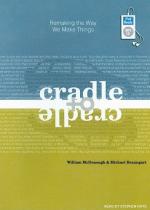|
This section contains 599 words (approx. 2 pages at 400 words per page) |

|
Cradle to Cradle Summary & Study Guide Description
Cradle to Cradle Summary & Study Guide includes comprehensive information and analysis to help you understand the book. This study guide contains the following sections:
This detailed literature summary also contains Topics for Discussion and a Free Quiz on Cradle to Cradle by William A. McDonough.
This is a book by two researchers who set out to find ways to build and manufacture things friendly to the environment. Their approach varies radically from the usual ecological approach, which, as the authors say, is to "be less bad." The typical approach tries to reduce the amount of toxins in a product, or attempts to collect and recycle goods, or to add expensive and bulky fixes to existing systems. Instead, the authors suggest that designers and manufacturers rethink and redesign materials with their end uses in mind. Using materials that are nontoxic and also that easily break down into quality materials results in byproducts that can be easily reused to manufacture items of first quality. The authors also recommend planning buildings and industrial complexes that utilize the surrounding environment for heating, cooling, and beautiful design. The strength of this book is that the suggestions here are not merely hypothetical. The book itself is made of a polymer plastic printed with nontoxic inks that easily wash off, thus making the material pristine and available to manufacture another beautiful book. The authors have worked on big projects, such as the redesign of the Ford facility in Michigan, based on these principles. The book is positive and specific on how to design and manufacture things for the greater good.
This book is different than virtually any other ecology books because it does not lay blame on any person or institution. At one point, the authors describe an ecological difficulty, and ask if it is important who is to blame. They answer, yes, and no. Perhaps those who are to blame need to acknowledge their actions, but the more important question is to ask what to do next. The authors acknowledge that even conceiving the changes necessary may be difficult, but again, what makes this book different than other ecological points of view is that the authors actually have conceived and implemented major projects with new, effective materials and practices. For example, they redesign the Ford Rouge automotive plant not only to make it safe now, but for generations. They cleanse the soil and add organisms to clean it deeply. They design water retention and cleansing practices that utilize nature. In another example, a factory in Germany is designed to have cross ventilation from open windows, to have all-day natural light from skylights, and to have pleasant, open workspaces. Some workers actually refuse higher pay in less friendly environments because they feel so good in the positive environment. One delightful difference in the points of view of these authors and many other ecologists is that this book insists on joy, fun, enjoyment, and positive thinking. Rather than making people feel guilty for buying and using things, the book encourages abundant, healthy design with easy recycling. As an example, the authors suggest installing a durable underlayment of carpet backing with snaps, so that healthy carpet can be snapped into place, enjoyed for a time, and then easily removed for replacement with another color or texture, all of healthy, affordable materials. The authors are not just hypothetical writers, though. They have actually designed and produced examples of many of their ideas, and at the same time, they invite other designers to take the challenge of thinking way outside the box.
The most important overlying principles through the book are using local environments to dictate design; using clean, friendly materials that can be easily reused to make quality items; not being "less bad" but being innovative in designing healthy things; and enjoying an abundant point of view the whole time.
Read more from the Study Guide
|
This section contains 599 words (approx. 2 pages at 400 words per page) |

|



